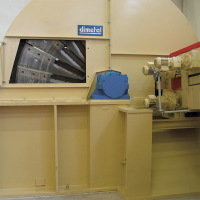
Measurement of the radial deviation of a cutter disk
During the manufacture of veneer strips from laminated wood, the precision of the cutting disk determines the quality of the final product. High demands are placed on the veneer strips in terms of dimensional conformance. The thickness of the strips must be less than 1 mm and may only have tolerances in the micrometer range. In order to comply with the quality criteria, the radial deviation of the cutting disk is measured and monitored during the production process using a non-contact optoNCDT 2300 laser triangulation sensor. This means that high demands are placed on the measuring system: Dust, chippings and a shiny target surface must not affect the measurement accuracy. The cutting disk has a diameter of 3200 mm and is equipped with 24 knives. The rotation speed is 180 to 210 rpm. |
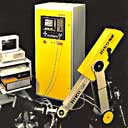
Position checking on robots
The introduction of the international standard ISO 9283 demands new non-contacting measurement methods. The measurement system for the position measurement is composed of a measurement cube with a defined weight, a sensor and a support. The sensor is equipped with six U15 eddy current sensors. During the measurement the robot moves the measurement cube into the sensor range. The data from the eddy current sensors is passed via a fast interface to the PC where it is processed. Measurement inaccuracies due to linearity and tilting errors (parallelism between the sensor and measurement object) and thermal effects are additionally compensated in the measurement software. |
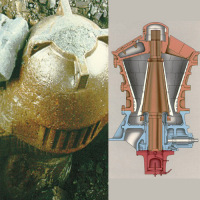
Exact crusher gap adjustment in rotary crushers
Rotary crushers for quarries or ore mines can grind up to 3500 t of material to the desired grain size in one hour. For this purpose an eccentric bearing bush generates a rotary-oscillating movement of the crusher axle, thereby constantly changing the gap between the crusher jaws and the crushing cone. For grinding the set gap continuously moves along the inside perimeter of the crushing room. With a longdistance sensor in the hydraulic cylinder the crushing gap can be exactly adjusted by raising and lowering the axle. |
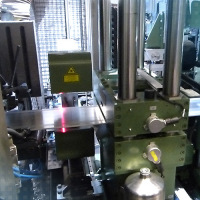
Non-contact thickness measurement of aluminum
For the prompt detection of incorrect thickness of aluminum strips, optoNCDT laser triangulation sensors are used as modern alternative solution to isotopic measuring systems. At the measurement location, the sensors are mounted opposite to each other, above and below the conveyed aluminum strip. Regardless of the exact height position of the strip, the sensors provide the exact material thickness based on a simple distance signal coupling, F=Ref. - (A + B). |
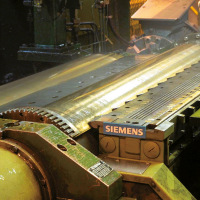
Flatness measurement in rolling mills
The requirements on the surface quality of rolled sheet metal are continually increasing. This may be steel sheet which is used, for example, for stainless steel fronts in kitchens, or also aluminum sheet used in the automotive field. The surface must be flawless to offer the customer a high quality visual appearance. Consequently, measurement equipment is employed in rolling mills to acquire the so-called flatness of the rolled sheet metal. Flatness is taken to mean the surface evenness of the sheet in the unstressed state. |
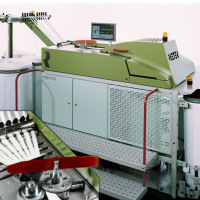
Yarn thickness
A consistent yarn thickness is a prerequisite in the textile industry for high quality products. Therefore, the naturally occurring yarn thickness fluctuations must be eliminated. The yarn is drawn to a constant thickness using a stretching tool. The measured data for controlling the stretching tool are provided by an eddy current sensor which indirectly measures the thickness. The thickness is transmitted to the eddy current sensor using sensing rollers. After the stretching, the result of the processing operation is also checked by an eddy current sensor. |
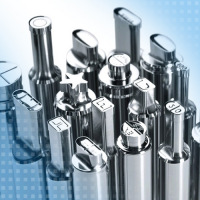
Wear inspection of tablet stamps
Press tools for the tablet production are subject to a continuous wear control. Due to complex geometries and strongly reflecting surfaces, optical inspections are only possible with high precision measuring techniques. A confocal sensor and an optical micrometer enable to inspect the tools in a special measuring machine. The press tools are tested for different parameters. |
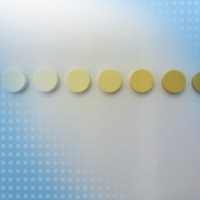
Color sensors monitor the ingredients of tablets
In pharmaceutical tablet production different ingredients are used. Changing the concentration of these ingredients affects the color of the tablet. The colorCONTROL ACS7000 inline color measuring system measures finely-graded color shades between white and beige. This color information provides a statement about the quality of the ingredient during the ongoing production. |
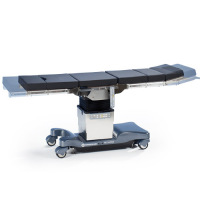
Displacement sensors for position monitoring in equipment manufacturing
For the measurement of a position, e.g. the movement of a patient couch, draw-wire displacement sensors are used. As positioning tasks typically require only medium accuracy, sensors with potentiometer outputs are suitable here. Extremely precise measurements, e.g. in computer tomographs with high sectional resolution require draw-wire sensors that offer a very accurate absolute or incremental encoder. |
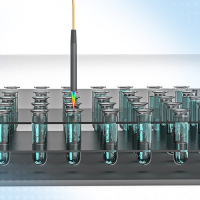
Filling level measurement trays
The narrow beam path enables the confocal sensors to measure in recesses. With the confocal measuring principle, measurements on liquids are possible, e.g. for precise filling level control in trays. |
